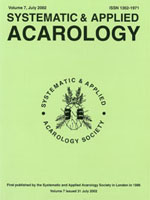Morphological methods of distinguishing the adult and larval stages of the ticks Ixodes cornuatus and I. holocyclus were examined, using specimens whose identity had been determined using multilocus enzyme electrophoresis. Individual morphological characters identified most, but not all specimens. The only character which unequivocally distinguished males of the two species was the shape of the epimeral plate. Statistical analyses of metric characters revealed significant differences between the two species and among populations of I. holocyclus. However, no single metric character permitted unequivocal identification of all specimens. Discriminant function analyses were employed, resulting in the differentiation of all specimens of both males and females of the two species. In the larval stages, the numbers of marginal dorsal setae and supplementary setae, as well as the lengths of posterior marginal dorsal setae, allowed identification of the two species. The results highlight the advantages of utilising morphological methods in conjunction with genetic techniques to provide markers for accurate identification and characterisation in instances in which taxonomic confusion exists.
How to translate text using browser tools
1 July 2002
Morphological comparison of the adult and larval stages of the Australian ticks Ixodes holocyclus Neumann, 1899 and I. cornuatus Roberts, 1960 (Acari : Ixodoidea)
J. Jackson,
I. Beveridge,
N.B. Chilton,
R.H. Andrews,
B. Dixon
ACCESS THE FULL ARTICLE

Systematic and Applied Acarology
Vol. 7 • No. 1
July 2002
Vol. 7 • No. 1
July 2002
discriminant functions
identification
Ixodes cornuatus
Ixodes holocyclus




